Paris
Paris | |
|---|---|
| Motto(s): | |
show Location of Paris | |
| Coordinates: 48°51′24″N 2°21′08″ECoordinates: 48°51′24″N 2°21′08″E | |
| Country | France |
| Region | Île-de-France |
| Department | Paris |
| Intercommunality | Métropole du Grand Paris |
| Subdivisions | 20 arrondissements |
| Government | |
| • Mayor (2020–2026) | Anne Hidalgo (PS) |
| Area 1 | 105.4 km2 (40.7 sq mi) |
| • Urban (2020) | 2,853.5 km2 (1,101.7 sq mi) |
| • Metro (2020) | 18,940.7 km2 (7,313.0 sq mi) |
| Population (Jan. 2019)[1] | 2,165,423 |
| • Density | 21,000/km2 (53,000/sq mi) |
| • Urban (2019[2]) | 10,858,852 |
| • Urban density | 3,800/km2 (9,900/sq mi) |
| • Metro (Jan. 2017[3]) | 13,024,518 |
| • Metro density | 690/km2 (1,800/sq mi) |
| Demonym(s) | Parisian(s) (en) Parisien(s) (masc.), Parisienne(s) (fem.) (fr), Parigot(s) (masc.), "Parigote(s)" (fem.) (fr, colloquial) |
| Time zone | UTC+01:00 (CET) |
| • Summer (DST) | UTC+02:00 (CEST) |
| INSEE/Postal code | 75056 /75001-75020, 75116 |
| Elevation | 28–131 m (92–430 ft) (avg. 78 m or 256 ft) |
| Website | www |
| 1 French Land Register data, which excludes lakes, ponds, glaciers > 1 km2 (0.386 sq mi or 247 acres) and river estuaries. | |
Paris (French pronunciation: [paʁi] (![]() listen)) is the capital and most populous city of France, with an estimated population of 2,165,423 residents in 2019 in an area of more than 105 km² (41 sq mi),[4] making it the 34th most densely populated city in the world in 2020.[5] Since the 17th century, Paris has been one of the world's major centres of finance, diplomacy, commerce, fashion, gastronomy, and science, For its leading role in the arts and sciences, as well as its very early system of street lighting, in the 19th century it became known as "the City of Light".[6] Like London, prior to the Second World War it was also sometimes called the capital of the world.
listen)) is the capital and most populous city of France, with an estimated population of 2,165,423 residents in 2019 in an area of more than 105 km² (41 sq mi),[4] making it the 34th most densely populated city in the world in 2020.[5] Since the 17th century, Paris has been one of the world's major centres of finance, diplomacy, commerce, fashion, gastronomy, and science, For its leading role in the arts and sciences, as well as its very early system of street lighting, in the 19th century it became known as "the City of Light".[6] Like London, prior to the Second World War it was also sometimes called the capital of the world.
The City of Paris is the centre of the region and province of Île-de-France, or Paris Region, with an estimated population of 12,262,544 in 2019, or about 19% of the population of France.[7] The Paris Region had a GDP of €739 billion ($743 billion) in 2019, which is the highest in Europe.[8] According to the Economist Intelligence Unit Worldwide Cost of Living Survey, in 2021, Paris was the city with the second-highest cost of living in the world, tied with Singapore, and after Tel Aviv.[9]
Paris is a major railway, highway, and air-transport hub served by two international airports: Paris–Charles de Gaulle (the second-busiest airport in Europe) and Paris–Orly.[10][11] Opened in 1900, the city's subway system, the Paris Métro, serves 5.23 million passengers daily;[12] it is the second-busiest metro system in Europe after the Moscow Metro. Gare du Nord is the 24th-busiest railway station in the world and the busiest located outside Japan, with 262 million passengers in 2015.[13] Paris is especially known for its museums and architectural landmarks: the Louvre received 2.8 million visitors in 2021, despite the long museum closings caused by the COVID-19 virus.[14] The Musée d'Orsay, Musée Marmottan Monet and Musée de l'Orangerie are noted for their collections of French Impressionist art. The Pompidou Centre Musée National d'Art Moderne has the largest collection of modern and contemporary art in Europe. The Musée Rodin and Musée Picasso exhibit the works of two noted Parisians. The historical district along the Seine in the city centre has been classified as a UNESCO World Heritage Site since 1991; popular landmarks there include the Cathedral of Notre Dame de Paris on the Île de la Cité, now closed for renovation after the 15 April 2019 fire. Other popular tourist sites include the Gothic royal chapel of Sainte-Chapelle, also on the Île de la Cité; the Eiffel Tower, constructed for the Paris Universal Exposition of 1889; the Grand Palais and Petit Palais, built for the Paris Universal Exposition of 1900; the Arc de Triomphe on the Champs-Élysées, and the hill of Montmartre with its artistic history and its Basilica of Sacré-Coeur.[15]
Paris hosts several United Nations organisations including UNESCO, and other international organisations such as the OECD, the OECD Development Centre, the International Bureau of Weights and Measures, the International Energy Agency, the International Federation for Human Rights, along with European bodies such as the European Space Agency, the European Banking Authority or the European Securities and Markets Authority.
The football club Paris Saint-Germain and the rugby union club Stade Français are based in Paris. The 80,000-seat Stade de France, built for the 1998 FIFA World Cup, is located just north of Paris in the neighbouring commune of Saint-Denis. Paris hosts the annual French Open Grand Slam tennis tournament on the red clay of Roland Garros. The city hosted the Olympic Games in 1900, 1924 and will host the 2024 Summer Olympics. The 1938 and 1998 FIFA World Cups, the 2007 Rugby World Cup, as well as the 1960, 1984 and 2016 UEFA European Championships were also held in the city. Every July, the Tour de France bicycle race finishes on the Avenue des Champs-Élysées in Paris.
Etymology[edit]
The ancient oppidum that corresponds to the modern city of Paris was first mentioned in the mid-1st century BC by Julius Caesar as Luteciam Parisiorum ('Lutetia of the Parisii'), and is later attested as Parision in the 5th century AD, then as Paris in 1265.[16][17] During the Roman period, it was commonly known as Lutetia or Lutecia in Latin, and as Leukotekía in Greek, which is interpreted as either stemming from the Celtic root *lukot- ('mouse'), or from *luto- ('marsh, swamp'), depending on whether the Latin or Greek form is the closest to the original Gaulish name.[18][19][17]
The name Paris is derived from its early inhabitants, the Parisii (Gaulish: Parisioi), a Gallic tribe from the Iron Age and the Roman period.[20] The meaning of the Gaulish ethnonym remains debated. According to Xavier Delamarre, it may derive from the Celtic root pario- ('cauldron').[20] Alfred Holder interpreted the name as 'the makers' or 'the commanders', by comparing it to the Welsh peryff ('lord, commander'), both possibly descending from a Proto-Celtic form reconstructed as *kwar-is-io-.[21] Alternatively, Pierre-Yves Lambert proposed to translate Parisii as the 'spear people', by connecting the first element to the Old Irish carr ('spear'), derived from an earlier *kwar-sā.[17] In any case, the city's name is not related to the Paris of Greek mythology.
Paris is often referred to as the 'City of Light' (La Ville Lumière),[22] both because of its leading role during the Age of Enlightenment and more literally because Paris was one of the first large European cities to use gas street lighting on a grand scale on its boulevards and monuments. Gas lights were installed on the Place du Carrousel, Rue de Rivoli and Place Vendome in 1829. By 1857, the Grand boulevards were lit.[23] By the 1860s, the boulevards and streets of Paris were illuminated by 56,000 gas lamps.[24] Since the late 19th century, Paris has also been known as Panam(e) (pronounced [panam]) in French slang.[25][why?]
Inhabitants are known in English as "Parisians" and in French as Parisiens ([paʁizjɛ̃] (![]() listen)). They are also pejoratively called Parigots ([paʁiɡo] (
listen)). They are also pejoratively called Parigots ([paʁiɡo] (![]() listen)).[note 1][26]
listen)).[note 1][26]
History[edit]
Origins[edit]
The Parisii, a sub-tribe of the Celtic Senones, inhabited the Paris area from around the middle of the 3rd century BC.[27][28] One of the area's major north–south trade routes crossed the Seine on the île de la Cité; this meeting place of land and water trade routes gradually became an important trading centre.[29] The Parisii traded with many river towns (some as far away as the Iberian Peninsula) and minted their own coins for that purpose.[30]
The Romans conquered the Paris Basin in 52 BC and began their settlement on Paris's Left Bank.[31] The Roman town was originally called Lutetia (more fully, Lutetia Parisiorum, "Lutetia of the Parisii", modern French Lutèce). It became a prosperous city with a forum, baths, temples, theatres, and an amphitheatre.[32]
By the end of the Western Roman Empire, the town was known as Parisius, a Latin name that would later become Paris in French.[33] Christianity was introduced in the middle of the 3rd century AD by Saint Denis, the first Bishop of Paris: according to legend, when he refused to renounce his faith before the Roman occupiers, he was beheaded on the hill which became known as Mons Martyrum (Latin "Hill of Martyrs"), later "Montmartre", from where he walked headless to the north of the city; the place where he fell and was buried became an important religious shrine, the Basilica of Saint-Denis, and many French kings are buried there.[34]
Clovis the Frank, the first king of the Merovingian dynasty, made the city his capital from 508.[35] As the Frankish domination of Gaul began, there was a gradual immigration by the Franks to Paris and the Parisian Francien dialects were born. Fortification of the Île de la Cité failed to avert sacking by Vikings in 845, but Paris's strategic importance—with its bridges preventing ships from passing—was established by successful defence in the Siege of Paris (885–886), for which the then Count of Paris (comte de Paris), Odo of France, was elected king of West Francia.[36] From the Capetian dynasty that began with the 987 election of Hugh Capet, Count of Paris and Duke of the Franks (duc des Francs), as king of a unified West Francia, Paris gradually became the largest and most prosperous city in France.[34]
High and Late Middle Ages to Louis XIV[edit]
By the end of the 12th century, Paris had become the political, economic, religious, and cultural capital of France.[37] The Palais de la Cité, the royal residence, was located at the western end of the Île de la Cité. In 1163, during the reign of Louis VII, Maurice de Sully, bishop of Paris, undertook the construction of the Notre Dame Cathedral at its eastern extremity.
After the marshland between the river Seine and its slower 'dead arm' to its north was filled in from around the 10th century,[38] Paris's cultural centre began to move to the Right Bank. In 1137, a new city marketplace (today's Les Halles) replaced the two smaller ones on the Île de la Cité and Place de Grève (Place de l'Hôtel de Ville).[39] The latter location housed the headquarters of Paris's river trade corporation, an organisation that later became, unofficially (although formally in later years), Paris's first municipal government.
In the late 12th century, Philip Augustus extended the Louvre fortress to defend the city against river invasions from the west, gave the city its first walls between 1190 and 1215, rebuilt its bridges to either side of its central island, and paved its main thoroughfares.[40] In 1190, he transformed Paris's former cathedral school into a student-teacher corporation that would become the University of Paris and would draw students from all of Europe.[41][37]
With 200,000 inhabitants in 1328, Paris, then already the capital of France, was the most populous city of Europe. By comparison, London in 1300 had 80,000 inhabitants.
By the early fourteenth century so much filth had collected inside urban Europe that French and Italian cities were naming streets after human waste. In medieval Paris, several street names were inspired by merde, the French word for “shit.” There were rue Merdeux, rue Merdelet, rue Merdusson, rue des Merdons, and rue Merdiere—as well as a rue du Pipi.[42]
During the Hundred Years' War, Paris was occupied by England-friendly Burgundian forces from 1418, before being occupied outright by the English when Henry V of England entered the French capital in 1420;[44] in spite of a 1429 effort by Joan of Arc to liberate the city,[45] it would remain under English occupation until 1436.
In the late 16th-century French Wars of Religion, Paris was a stronghold of the Catholic League, the organisers of 24 August 1572 St. Bartholomew's Day massacre in which thousands of French Protestants were killed.[46][47] The conflicts ended when pretender to the throne Henry IV, after converting to Catholicism to gain entry to the capital, entered the city in 1594 to claim the crown of France. This king made several improvements to the capital during his reign: he completed the construction of Paris's first uncovered, sidewalk-lined bridge, the Pont Neuf, built a Louvre extension connecting it to the Tuileries Palace, and created the first Paris residential square, the Place Royale, now Place des Vosges. In spite of Henry IV's efforts to improve city circulation, the narrowness of Paris's streets was a contributing factor in his assassination near Les Halles marketplace in 1610.[48]
During the 17th century, Cardinal Richelieu, chief minister of Louis XIII, was determined to make Paris the most beautiful city in Europe. He built five new bridges, a new chapel for the College of Sorbonne, and a palace for himself, the Palais-Cardinal, which he bequeathed to Louis XIII. After Richelieu's death in 1642, it was renamed the Palais-Royal.[49]
Due to the Parisian uprisings during the Fronde civil war, Louis XIV moved his court to a new palace, Versailles, in 1682. Although no longer the capital of France, arts and sciences in the city flourished with the Comédie-Française, the Academy of Painting, and the French Academy of Sciences. To demonstrate that the city was safe from attack, the king had the city walls demolished and replaced with tree-lined boulevards that would become the Grands Boulevards of today.[50] Other marks of his reign were the Collège des Quatre-Nations, the Place Vendôme, the Place des Victoires, and Les Invalides.[51]
18th and 19th centuries[edit]
Paris grew in population from about 400,000 in 1640 to 650,000 in 1780.[52] A new boulevard, the Champs-Élysées, extended the city west to Étoile,[53] while the working-class neighbourhood of the Faubourg Saint-Antoine on the eastern site of the city grew more and more crowded with poor migrant workers from other regions of France.[54]
Paris was the centre of an explosion of philosophic and scientific activity known as the Age of Enlightenment. Diderot and d'Alembert published their Encyclopédie in 1751, and the Montgolfier Brothers launched the first manned flight in a hot-air balloon on 21 November 1783, from the gardens of the Château de la Muette. Paris was the financial capital of continental Europe, the primary European centre of book publishing and fashion and the manufacture of fine furniture and luxury goods.[55]
In the summer of 1789, Paris became the centre stage for the French Revolution. On 14 July, a mob seized the arsenal at the Invalides, acquiring thousands of guns, and stormed the Bastille, a symbol of royal authority. The first independent Paris Commune, or city council, met in the Hôtel de Ville and, on 15 July, elected a Mayor, the astronomer Jean Sylvain Bailly.[56]
Louis XVI and the royal family were brought to Paris and made prisoners within the Tuileries Palace. In 1793, as the revolution turned more and more radical, the king, queen, and the mayor were guillotined (executed) in the Reign of Terror, along with more than 16,000 others throughout France.[57] The property of the aristocracy and the church was nationalised, and the city's churches were closed, sold or demolished.[58] A succession of revolutionary factions ruled Paris until 9 November 1799 (coup d'état du 18 brumaire), when Napoléon Bonaparte seized power as First Consul.[59]
The population of Paris had dropped by 100,000 during the Revolution, but between 1799 and 1815, it surged with 160,000 new residents, reaching 660,000.[60] Napoleon Bonaparte replaced the elected government of Paris with a prefect reporting only to him. He began erecting monuments to military glory, including the Arc de Triomphe, and improved the neglected infrastructure of the city with new fountains, the Canal de l'Ourcq, Père Lachaise Cemetery and the city's first metal bridge, the Pont des Arts.[60]
During the Restoration, the bridges and squares of Paris were returned to their pre-Revolution names; the July Revolution in 1830 (commemorated by the July Column on the Place de la Bastille) brought a constitutional monarch, Louis Philippe I, to power. The first railway line to Paris opened in 1837, beginning a new period of massive migration from the provinces to the city.[60] Louis-Philippe was overthrown by a popular uprising in the streets of Paris in 1848. His successor, Napoleon III, alongside the newly appointed prefect of the Seine, Georges-Eugène Haussmann, launched a gigantic public works project to build wide new boulevards, a new opera house, a central market, new aqueducts, sewers and parks, including the Bois de Boulogne and Bois de Vincennes.[61] In 1860, Napoleon III also annexed the surrounding towns and created eight new arrondissements, expanding Paris to its current limits.[61]
During the Franco-Prussian War (1870–1871), Paris was besieged by the Prussian Army. After months of blockade, hunger, and then bombardment by the Prussians, the city was forced to surrender on 28 January 1871. On 28 March, a revolutionary government called the Paris Commune seized power in Paris. The Commune held power for two months, until it was harshly suppressed by the French army during the "Bloody Week" at the end of May 1871.[62]
Late in the 19th century, Paris hosted two major international expositions: the 1889 Universal Exposition, was held to mark the centennial of the French Revolution and featured the new Eiffel Tower; and the 1900 Universal Exposition, which gave Paris the Pont Alexandre III, the Grand Palais, the Petit Palais and the first Paris Métro line.[63] Paris became the laboratory of Naturalism (Émile Zola) and Symbolism (Charles Baudelaire and Paul Verlaine), and of Impressionism in art (Courbet, Manet, Monet, Renoir).[64]
20th and 21st centuries[edit]
By 1901, the population of Paris had grown to about 2,715,000.[65] At the beginning of the century, artists from around the world including Pablo Picasso, Modigliani, and Henri Matisse made Paris their home. It was the birthplace of Fauvism, Cubism and abstract art,[66][67] and authors such as Marcel Proust were exploring new approaches to literature.[68]
During the First World War, Paris sometimes found itself on the front line; 600 to 1,000 Paris taxis played a small but highly important symbolic role in transporting 6,000 soldiers to the front line at the First Battle of the Marne. The city was also bombed by Zeppelins and shelled by German long-range guns.[69] In the years after the war, known as Les Années Folles, Paris continued to be a mecca for writers, musicians and artists from around the world, including Ernest Hemingway, Igor Stravinsky, James Joyce, Josephine Baker, Eva Kotchever, Henry Miller, Anaïs Nin, Sidney Bechet[70] Allen Ginsberg[71] and the surrealist Salvador Dalí.[72]
In the years after the peace conference, the city was also home to growing numbers of students and activists from French colonies and other Asian and African countries, who later became leaders of their countries, such as Ho Chi Minh, Zhou Enlai and Léopold Sédar Senghor.[73]
On 14 June 1940, the German army marched into Paris, which had been declared an "open city".[74] On 16–17 July 1942, following German orders, the French police and gendarmes arrested 12,884 Jews, including 4,115 children, and confined them during five days at the Vel d'Hiv (Vélodrome d'Hiver), from which they were transported by train to the extermination camp at Auschwitz. None of the children came back.[75][76] On 25 August 1944, the city was liberated by the French 2nd Armoured Division and the 4th Infantry Division of the United States Army. General Charles de Gaulle led a huge and emotional crowd down the Champs Élysées towards Notre Dame de Paris, and made a rousing speech from the Hôtel de Ville.[77]
In the 1950s and the 1960s, Paris became one front of the Algerian War for independence; in August 1961, the pro-independence FLN targeted and killed 11 Paris policemen, leading to the imposition of a curfew on Muslims of Algeria (who, at that time, were French citizens). On 17 October 1961, an unauthorised but peaceful protest demonstration of Algerians against the curfew led to violent confrontations between the police and demonstrators, in which at least 40 people were killed, including some thrown into the Seine. The anti-independence Organisation armée secrète (OAS), for their part, carried out a series of bombings in Paris throughout 1961 and 1962.[78][79]
In May 1968, protesting students occupied the Sorbonne and put up barricades in the Latin Quarter. Thousands of Parisian blue-collar workers joined the students, and the movement grew into a two-week general strike. Supporters of the government won the June elections by a large majority. The May 1968 events in France resulted in the break-up of the University of Paris into 13 independent campuses.[80] In 1975, the National Assembly changed the status of Paris to that of other French cities and, on 25 March 1977, Jacques Chirac became the first elected mayor of Paris since 1793.[81] The Tour Maine-Montparnasse, the tallest building in the city at 57 storeys and 210 metres (689 feet) high, was built between 1969 and 1973. It was highly controversial, and it remains the only building in the centre of the city over 32 storeys high.[82] The population of Paris dropped from 2,850,000 in 1954 to 2,152,000 in 1990, as middle-class families moved to the suburbs.[83] A suburban railway network, the RER (Réseau Express Régional), was built to complement the Métro; the Périphérique expressway encircling the city, was completed in 1973.[84]
Most of the postwar's Presidents of the Fifth Republic wanted to leave their own monuments in Paris; President Georges Pompidou started the Centre Georges Pompidou (1977), Valéry Giscard d'Estaing began the Musée d'Orsay (1986); President François Mitterrand, in power for 14 years, built the Opéra Bastille (1985–1989), the new site of the Bibliothèque nationale de France (1996), the Arche de la Défense (1985–1989), and the Louvre Pyramid with its underground courtyard (1983–1989); Jacques Chirac (2006), the Musée du quai Branly.[85]
In the early 21st century, the population of Paris began to increase slowly again, as more young people moved into the city. It reached 2.25 million in 2011. In March 2001, Bertrand Delanoë became the first Socialist Mayor of Paris. In 2007, in an effort to reduce car traffic in the city, he introduced the Vélib', a system which rents bicycles for the use of local residents and visitors. Bertrand Delanoë also transformed a section of the highway along the Left Bank of the Seine into an urban promenade and park, the Promenade des Berges de la Seine, which he inaugurated in June 2013.[86]
In 2007, President Nicolas Sarkozy launched the Grand Paris project, to integrate Paris more closely with the towns in the region around it. After many modifications, the new area, named the Metropolis of Grand Paris, with a population of 6.7 million, was created on 1 January 2016.[87] In 2011, the City of Paris and the national government approved the plans for the Grand Paris Express, totalling 205 kilometres (127 miles) of automated metro lines to connect Paris, the innermost three departments around Paris, airports and high-speed rail (TGV) stations, at an estimated cost of €35 billion.[88] The system is scheduled to be completed by 2030.[89]
In January 2015, Al-Qaeda in the Arabian Peninsula claimed attacks across the Paris region.[90][91] 1.5 million people marched in Paris in a show of solidarity against terrorism and in support of freedom of speech.[92] In November of the same year, terrorist attacks, claimed by ISIL,[93] killed 130 people and injured more than 350.[94]
Geography[edit]
Location[edit]
Paris is located in northern central France, in a north-bending arc of the river Seine whose crest includes two islands, the Île Saint-Louis and the larger Île de la Cité, which form the oldest part of the city. The river's mouth on the English Channel (La Manche) is about 233 mi (375 km) downstream from the city. The city is spread widely on both banks of the river.[95] Overall, the city is relatively flat, and the lowest point is 35 m (115 ft) above sea level. Paris has several prominent hills, the highest of which is Montmartre at 130 m (427 ft).[96]
Excluding the outlying parks of Bois de Boulogne and Bois de Vincennes, Paris covers an oval measuring about 87 km2 (34 sq mi) in area, enclosed by the 35 km (22 mi) ring road, the Boulevard Périphérique.[97] The city's last major annexation of outlying territories in 1860 not only gave it its modern form but also created the 20 clockwise-spiralling arrondissements (municipal boroughs). From the 1860 area of 78 km2 (30 sq mi), the city limits were expanded marginally to 86.9 km2 (33.6 sq mi) in the 1920s. In 1929, the Bois de Boulogne and Bois de Vincennes forest parks were officially annexed to the city, bringing its area to about 105 km2 (41 sq mi).[98] The metropolitan area of the city is 2,300 km2 (890 sq mi).[95]
Measured from the 'point zero' in front of its Notre-Dame cathedral, Paris by road is 450 kilometres (280 mi) southeast of London, 287 kilometres (178 mi) south of Calais, 305 kilometres (190 mi) southwest of Brussels, 774 kilometres (481 mi) north of Marseille, 385 kilometres (239 mi) northeast of Nantes, and 135 kilometres (84 mi) southeast of Rouen.[99]
Climate[edit]
Paris has a typical Western European oceanic climate (Köppen: Cfb), which is affected by the North Atlantic Current. The overall climate throughout the year is mild and moderately wet.[100] Summer days are usually warm and pleasant with average temperatures between 15 and 25 °C (59 and 77 °F), and a fair amount of sunshine.[101] Each year, however, there are a few days when the temperature rises above 32 °C (90 °F). Longer periods of more intense heat sometimes occur, such as the heat wave of 2003 when temperatures exceeded 30 °C (86 °F) for weeks, reached 40 °C (104 °F) on some days and rarely cooled down at night.[102] Spring and autumn have, on average, mild days and fresh nights but are changing and unstable. Surprisingly warm or cool weather occurs frequently in both seasons.[103] In winter, sunshine is scarce; days are cool, and nights are cold but generally above freezing with low temperatures around 3 °C (37 °F).[104] Light night frosts are however quite common, but the temperature seldom dips below −5 °C (23 °F). Snow falls every year, but rarely stays on the ground. The city sometimes sees light snow or flurries with or without accumulation.[105]
Paris has an average annual precipitation of 641 mm (25.2 in), and experiences light rainfall distributed evenly throughout the year. However, the city is known for intermittent, abrupt, heavy showers. The highest recorded temperature was 42.6 °C (108.7 °F) on 25 July 2019,[106] and the lowest was −23.9 °C (−11.0 °F) on 10 December 1879.[107]










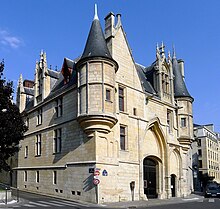

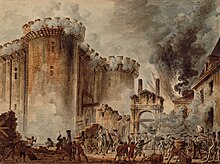
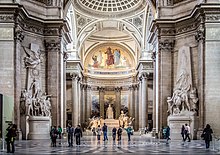




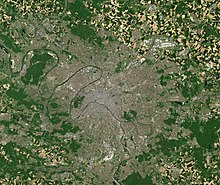
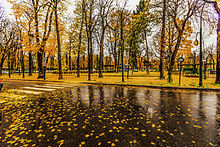

Tidak ada komentar:
Posting Komentar